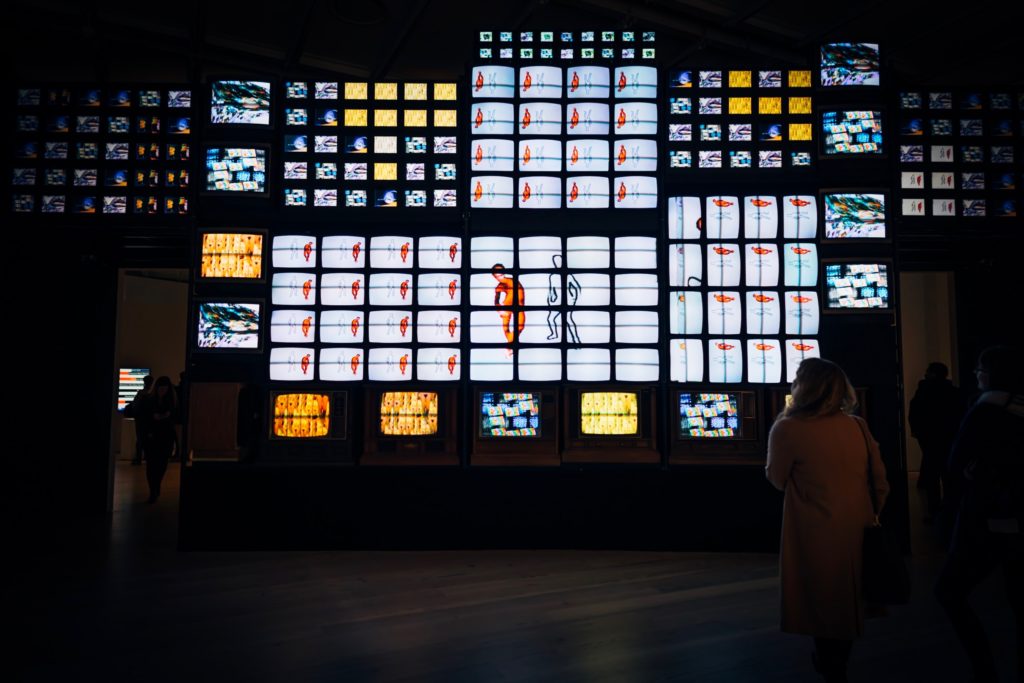
On March 29th 2019, I visited this exhibit and was transfixed by the main installation, which is a floor to ceiling panel of television sets. It is important to note that when I visited the exhibit, the museum was also showcasing its final weekend of their Andy Warhol exhibit. There was also an organized protest that was taking place at 7pm during the museum’s pay-as-you-wish period. The museum was jam packed with ticket buyers, members, and security staff. Although it was a high capacity evening, my access to the museum’s Programmed exhibit was smooth and calm.
The content in this exhibit celebrates art through programmable codes (or instructions) and how these codes can be used to manipulate the artists’ medium (computerized program or image sequence). All of the pieces in this exhibit were created through various types of computer programs, which were used to establish the structure and color of the piece. They are grouped in one of two sections: “Rule, Instruction, Algorithm”, which focuses on the rule-based conceptual art practices prior to digital art technologies and “Signal, Sequence, Resolution”, which focuses on the coding and manipulation of the moving image. Walking through the exhibit it was hard for me to differentiate between these two groups since nearly every piece has some sort of tech-based manipulation applied to it.
This exhibit is very open and full of content. Navigating the exhibit can be overwhelming because there was music playing from the main attraction, Nam June Paik’s Fin de Siecle II (pictured above) and other installations around it. Adding to the noise from the installations are the human noises produced by the visitors and employees. I also noticed many people gravitated towards the multimedia content more so than a piece that did not openly appear to have a tech component to it.

Tilted Plane (pictured above) is a great example of one installation receiving more “people time” than other pieces. I think a big part of why this installation attracted more visitors than others is because of how “instagrammable” it looked. Jim Campbell created this piece in 2011 to project a two-dimensional image into a three-dimensional space. To do this, he placed modified LED lights at specific locations on a circuit board to mimic pixels in a low-resolution display. The viewer would enter at the spot Whitney staff has sectioned off as the entrance, which allows you to see the initial sight of birds taking off and landing. But as the viewer moved along, the image becomes distorted, and random, creating the illusion that you are no longer looking at a specific thing, but something abstract.
Being immersed in Tilted Plane not only gave me a serious case of dizziness (a warning sign was placed outside the installation about this) but also immediately reminded me of Bates (2003) and her discussion on natural and represented information. According to Bates, these forms of information allow for organization of knowledge and representation of this knowledge through other means. When applied to how the pieces in this exhibit was created, I can’t help but think about the process in which each artist came up with their initial concept (encoded information), their process of creating such pieces (embodied information), and the completion or exhibiting of their piece (exosomatic information).
Another piece from the exhibit that I found interesting is The Interactions of Coloreds by Mendi + Keith Obadike. It is important to note that this installation was not as popular as Tilted Plane, but exhibited some important themes that should be looked at. This interactive piece invited the viewers to look at the conceptual website created by the artists to see how skin color has effected online commerce and ad-targeting. However, as the gallery attendant for the exhibition explained to me when I had trouble figuring out how to use the installation, the website built by the artists is not updated in real-time and tends to lag. Their website can be accessed here
Their “product” is a system that can help companies judge their customers or employees based on their hexadecimal color (the HTML equivalent of color). To add an interactive component to their website, they include a link that brings their viewers to a Google Doc questionnaire, which is to be filled out to compile the hex code for the viewer. Compiling this information is no different from Big Data firms collecting information from their users to better direct ads towards them to sell a product or sway them towards voting for a specific party or person. On the darker side of things, sometimes even limiting our access to important resources is a flaw in the types of systems offered to us in the real world. Costanza-Choke (2018) argues about these design injustices, where dominant groups oppress those who are often underrepresented because of their lack of access to resources that will help voice their concerns.
This installation reminds me of Sephora’s Color iQ, a “beauty service” tool that scans the surface of your skin to match makeup users to a host of foundations appropriate for their skin tone and color. Each Sephora customer that has used this service is then matched up with a 4-digit and letter combination code that is linked to specific shades in the brands they carry. From a consumer point of view, this tool is useful since it gives me a curated look at products from brands that are guaranteed to work for me. But looking at it from an information science student’s point of view, I wonder how that information has been used since then.
Overall, Programmed is an exciting exhibition looking at alternate forms of art through digital manipulation. While pieces that had great aesthetic appeal harnessed more attention from visitors, other pieces had more alluring underlying themes that provoked viewers to look at them more closely.
Tiffany Chan, Info 601 – 01
References:
· Bates, Marcia J. (2006). “Fundamental forms of information.” Journal of the American Society for Information and Technology 57(8): 1033–1045.
· Costanza-Chock, Sasha. (2018). “Design Justice: Towards an Intersectional Feminist Framework for Design Theory and Practice.” Proceedings of the Design Research Society 2018.